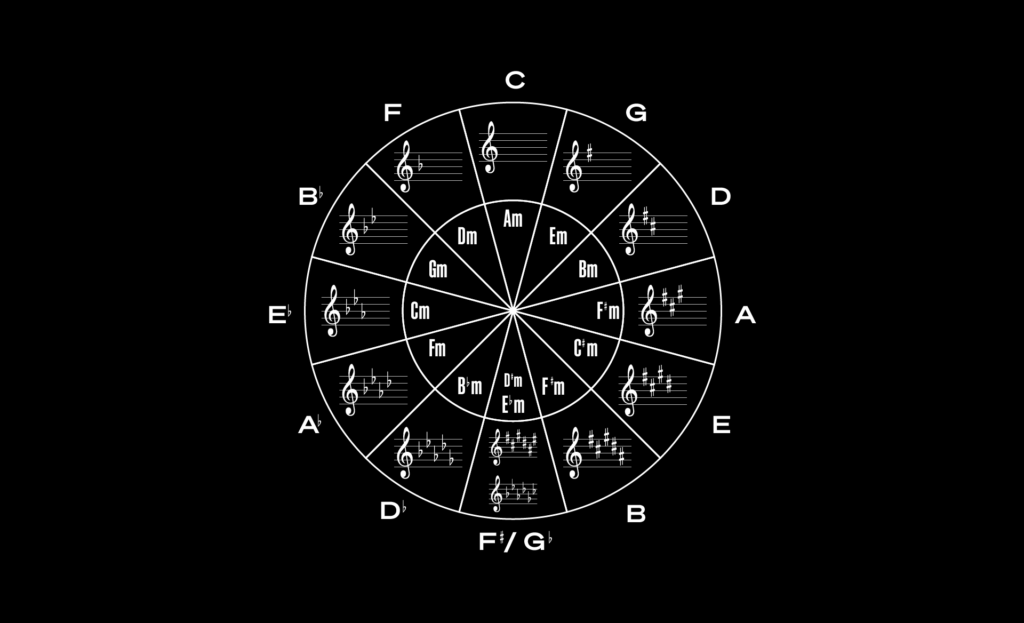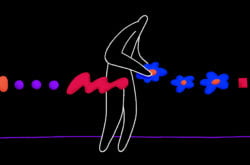Illustration: Michael Haddad
The circle of fifths is one of the most commonly referenced topics in music theory.
However, if you’ve learned how to make music outside of traditional academic settings, you may have actually never encountered the concept or deciphered its significance. In this article, let’s discuss what the circle of fifths is, how it works, and how you can benefit from having an understanding of it, regardless of the type of music you make.
Feel free to use the table of contents below to easily navigate to a specific section.
What you’ll learn about the circle of fifths:
Feeling ready? Let’s dive in!
What is the circle of fifths?
The circle of fifths is a diagram that shows the relationship between different keys in music. The keys that include sharps appear on the right of the circle, while the keys that include flats appear on the left. The key of C major, which doesn’t include any sharps or flats, sits at the center.

A chart that outlines the circle of fifths
If you follow the chart clockwise, you’ll see that a sharp is added with each key: C major contains no sharps, G major contains one sharp, D major contains two sharps, and so on. Additionally, you may have noticed that the pitches that correspond with each key are a perfect fifth higher than the previous pitch that followed in the circle (the distance between C and G is a perfect fifth, the distance between G and D is a perfect fifth, and so on). This is why the chart is known as the circle of fifths.
On the other hand, if you follow the chart counterclockwise, you’ll see that a flat is added with each key: C major contains no flats, F major contains one flat, B♭ major contains two flats, and so on. And this time, each pitch is a perfect fourth higher than the last (the distance between C and F is a perfect fourth, the distance between F and B♭ is a perfect fourth, and so on).
The circle of fifths with relative minor keys
The circle of fifths can be seamlessly applied to minor keys as well. Each major key has a relative minor key, which is a key with the same number of sharps and flats. For example, the relative minor key of C major is A minor (both have no sharps or flats), and the relative minor key of E♭ major is C minor (both have three flats). The relative minor key is always three semitones below its corresponding major key.
In the chart above, you can see the minor keys located below their relative major keys. The relationships between them are equivalent to their major counterparts.
For a deeper refresher on keys, intervals, and relative keys, check out our introductory guide to melody.
A free downloadable / printable chart
Now that you understand what the circle of fifths is, you may be interested in being able to have it readily available at your fingertips.
If so, you can download a high-quality version of our circle of fifths chart for absolutely free by clicking here. Keep it in a folder for offline use, make it your desktop wallpaper, or print it out—do whatever you need to do!
Why the circle of fifths is important
With definitions out of the way, why should you really care about the circle of fifths?
At its core, the circle of fifths is a useful tool for beginners who are trying to familiarize themselves with different key signatures. It allows you to easily identify how many sharps or flats are in each, and how different keys are related to one another. In fact, diagrams similar to the one above have been included in music theory textbooks since all the way back in the eighteenth century.
That said, the circle isn’t just a visual tool—it can also have some very relevant applications when you’re composing music. Below, we discuss a few different ways you can apply the circle of fifths in your music.
How to use the circle of fifths in your music
While the circle of fifths is somewhat plain on the surface, it actually sheds light on something that’s very powerful: the ‘distance’ between different keys. When we look at it from this perspective, we can start to identify some really interesting applications.
1. Modulation
Let’s say you want to modulate, or transition to a new key in your music. In popular music, the most common thing to do is to simply go up by a half step or whole step, as done in the final choruses of countless hits.
The last chorus in Whitney Houston’s “I Will Always Love You” raises the final chorus by a whole step for dramatic effect.
However, if you want to try something different, you can use the circle of fifths to find an adjacent key for modulation. For example, we can assume that moving from the key of C to the key of G will most likely sound fairly smooth, because thanks to the chart we know that they only have a single pitch that they don’t share in common: F♮ / F♯.
Once we’ve found two keys, we can try an abrupt modulation, or use a pivot chord (a chord that both keys share in common—like Am, for example) to move smoothly between them.
On the other hand, if you move to a key that’s more distant on the circle—for example, from F major to A major—you’ll find that the shift in tonality will feel much more pronounced. This isn’t necessarily a bad thing depending on the effect you want to achieve, but it’s certainly something to keep in mind.
Lastly, it’s commonly said that moving to a key with more sharps / less flats will make things sound ‘brighter,’ while moving to a key with less sharps / more flats will make things sound ‘darker.’ That said, context is always everything—definitely try experimenting with both directions yourself to see how they make you feel firsthand.
2. Chord progressions
Even if you don’t change keys, you can still use the patterns found within the circle of fifths in your chord progressions. By building a string of diatonic chords in any key off of the pitches in the circle, you can create a progression that sounds highly pleasing to the ear.
David Bennett does a great job at detailing this kind of chord progression in the video below, where he explores how it works and some popular songs that make use of it:
Because you’re moving in a succession of perfect fifths, it almost feels like a bunch of mini-cadences are constantly resolving in the progression. This helps achieve the satisfying feeling that Bennett points out when he says, “With each chord change, it just sounds like we’re landing in the ‘correct’ place.”
Gloria Gaynor’s “I Will Survive” just might be the poster child for this chord progression.
This is by no means an exhaustive list of the ways you can use the circle of fifths in your music. However, modulation and chord progressions are certainly solid starting points that you can use to begin exploring other possibilities.
Conclusion
The circle of fifths is a bit like a mixing console—at the first glance, it looks intimidating because there’s a lot going on. However, once you look a little closer, it becomes clear that it’s actually just a simple pattern that repeats itself over and over.
Hopefully this article helped you understand what the circle of fifths is, why it’s important, and how you can incorporate it into your music. If you’re looking to continue exploring more topics similar to this one, consider checking out our other articles on music theory.
Explore more tips and tutorials that break down concepts in music theory:
June 15, 2022



